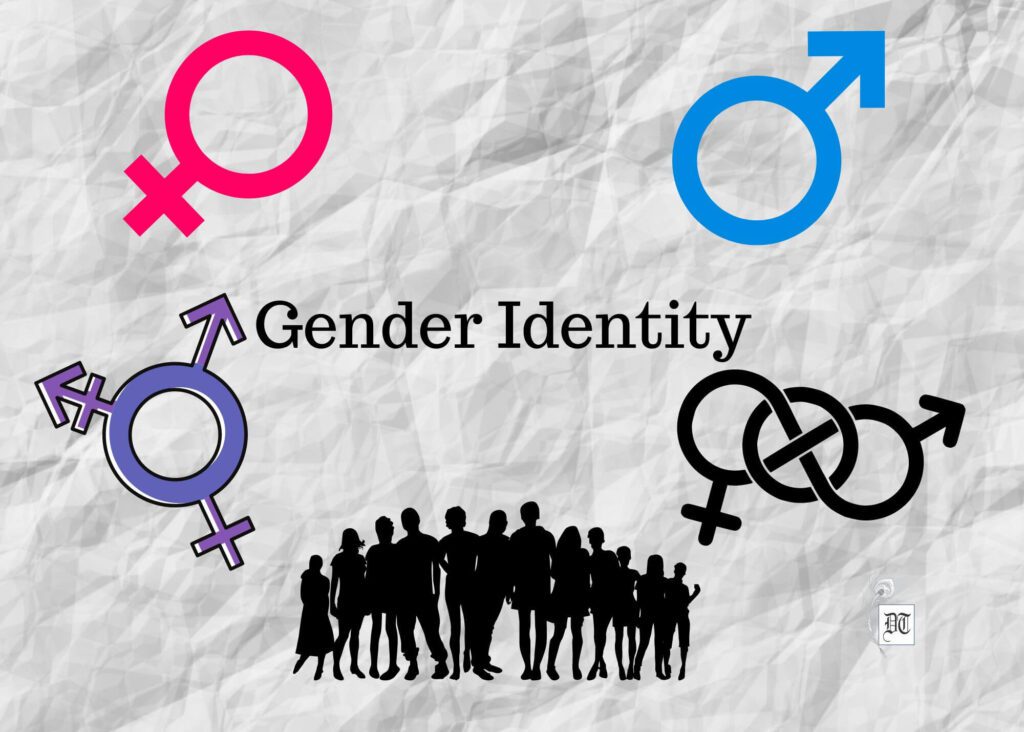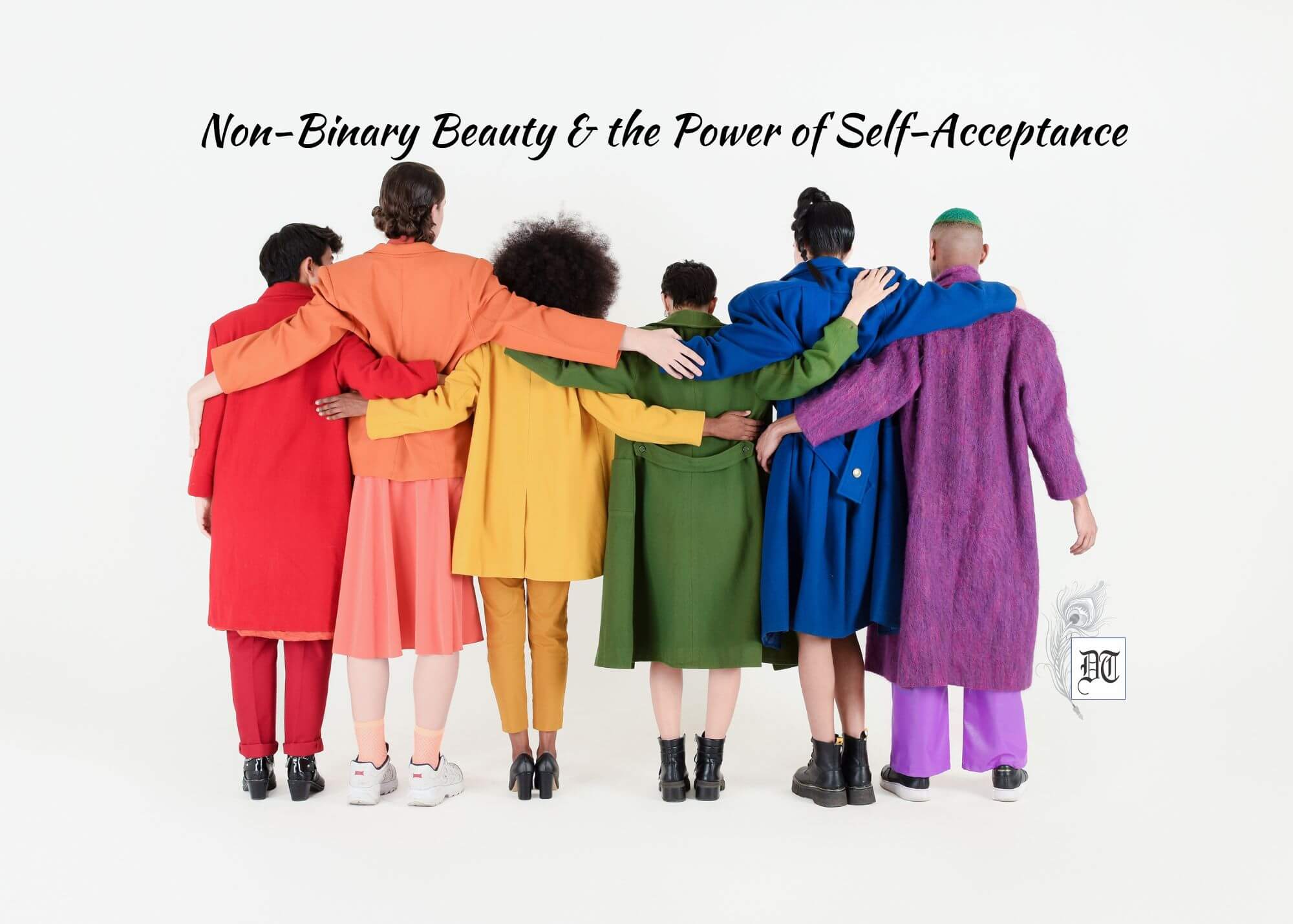Reading Time: 7 minutes
In a bold challenge to societal norms, non-binary individuals are pushing boundaries and redefining beauty through a journey of self-discovery, rebellion, and resilience, explains Shaivya, writing exclusively for Different Truths.

Non-binary people are challenging the status quo in a world where the strict binary notion of beauty has long confined us. The courageous souls are redefining the very essence of what is called beauty. Their journey is not just about aesthetics but also about self-discovery, rebellion, and resilience. They grapple with the pressure to conform to binary traditional norms; growing up, they find themselves in a fix between societal expectations and their sense of identity.
Make-up becomes a powerful tool for experimentation, it becomes a canvas where they can explore their expressions. Whether it’s an unconventional lip color, glitter, or bold eyeshadow, such makeup helps them express their identity, challenge rigid societal norms, and celebrate their uniqueness, where the binary-thinking beauty industry fails to keep pace with this gender fluidity.
For decades, societal assumptions about gender and sexuality have persistently clung to the outward appearance of an individual. The adjustment of the hair and makeup choices is to avoid being gendered. The persistent misconception that femininity equals makeup and that non-binary individuals must conform to either male or female categories are prevalent.
The beauty industry, too, perpetuates these limitations, and the non-binary confront this beauty landscape that rarely accommodates their diverse expressions. The emotional turmoil of feeling unrepresented and unseen in the binary mould fuels them with a powerful drive to bring about change, as despite the notable progress, our society leaves non-binary voices out of the discourse.
Many prominent figures and LGBTQIA+ activists challenge gender norms through their makeup and fashion.
Indian beauty standards need to embrace a broader spectrum, liberated from binary standards. Many prominent figures and LGBTQIA+ activists challenge gender norms through their makeup and fashion. Jezz Chung, a Brooklyn-based writer, public speaker, and performance artist, considers makeup a way to adorn and express feelings. Even though there are a few people making waves, there is much more to be done.
The non-binary perspective deserves the spotlight and deserves to be unshackled from binary norms. Its perspectives on beauty emphasize the importance of authenticity and transcending superficial standards. Alex, a non-binary actor, sees beauty as synonymous with authenticity. For Alex, non-binary perspectives on beauty offer a profound shift away from superficial standards, emphasizing authenticity and importance. For non-binary individuals like Alex, ‘true beauty’ is found in unapologetically expressing and embracing oneself, breaking free from the binary-driven society.
Clothing, too, has been a tool for self-expression. From fluid silhouettes to electrical style challenges, it has been the nonbinary wardrobe choice for generations. It is all about what makes you feel confident and true to yourself. Certain hairstyles and beauty practices have long confined individuals to the traditional binary mold. The non-binary perspective on beauty dismantles such expectations. Jules, a non-binary hair stylist, emphasises the power of natural beauty. According to him, hair is the extension of the individual self, and how they choose to express it is entirely personal.
Non-binary individuals encounter significant challenges due to a lack of representation in conventional beauty norms.
Non-binary individuals encounter significant challenges due to a lack of representation in conventional beauty norms. They are trying to carve out spaces for representation, through a kaleidoscope of beauty that transcends traditional norms and is reshaping the limitations of the binary beauty paradigm. Through experimentation with bold colors in makeup and clothing style, they assert their identity by embracing all their facets and rejecting social expectations.
Their bold aesthetics are a resistance and challenge to oppressive norms, reclaiming autonomy over their body and expression. In doing so, they navigate through a deeply emotional journey of self-discovery, self-assertion, and defiance in a world that often confines them to narrow definitions. It is their journey of self-love and acceptance; it is about understanding that beauty doesn’t fit into a predetermined mold but is uniquely theirs.
As the non-binary perspective on beauty and makeup becomes visible, there is an increase in the number of beauty brands to align with the diversity of their clientele. Brands offer products suitable for all genders by adopting an inclusive marketing strategy, as non-binary individuals navigate the market in search of products that resonate with their identities. This push to dismantle the binary beauty standard extends beyond the non-binary. The supporting brands promote gender-neutral ideals and advocate for inclusive representation, embracing the diverse expression of beauty.
The emotional impact of the allyship of the beauty brands is profound.
The emotional impact of the allyship of the beauty brands is profound. It makes the non-binary individual seen, heard, and valued. The solidarity cultivated through this revolution creates a sense of community that transcends beauty boundaries, untying people around the shared belief that beauty is diverse, fluid, and inherently personal. It is more than just a passing trend; it is a transformative paradigm shift in how society celebrates beauty. The non-binary individuals are shattering the binary beauty archetype and paving a path where authenticity, diversity, self-acceptance, and self-love define the true benchmark of beauty.
References
1. Steele, V. (2010). The transgender paradigm shift toward free expression. In J. Smith (Ed.), Transgender issues and lifestyles (pp. 77-96). Nova Science Publishers.
2. Tan, M. (2018). Trans fashion: Constructing, deconstructing, and beyond. Fashion Theory, 22(5), 523-548. https://doi.org/10.1080/1362704X.2018.1527282
3. Tarrant, S. (2018). Fashioning gender: Transgender and fashion studies. Fashion Theory, 22(5), 491-495. https://doi.org/10.1080/1362704X.2018.1527281
Picture design by Anumita Roy
In a bold challenge to societal norms, non-binary individuals are pushing boundaries and redefining beauty through a journey of self-discovery, rebellion, and resilience, explains Shaivya, writing exclusively for Different Truths.
Non-binary people are challenging the status quo in a world where the strict binary notion of beauty has long confined us. The courageous souls are redefining the very essence of what is called beauty. Their journey is not just about aesthetics but also about self-discovery, rebellion, and resilience. They grapple with the pressure to conform to binary traditional norms; growing up, they find themselves in a fix between societal expectations and their sense of identity.
Make-up becomes a powerful tool for experimentation, it becomes a canvas where they can explore their expressions. Whether it’s an unconventional lip color, glitter, or bold eyeshadow, such makeup helps them express their identity, challenge rigid societal norms, and celebrate their uniqueness, where the binary-thinking beauty industry fails to keep pace with this gender fluidity.
For decades, societal assumptions about gender and sexuality have persistently clung to the outward appearance of an individual. The adjustment of the hair and makeup choices is to avoid being gendered. The persistent misconception that femininity equals makeup and that non-binary individuals must conform to either male or female categories are prevalent.
The beauty industry, too, perpetuates these limitations, and the non-binary confront this beauty landscape that rarely accommodates their diverse expressions. The emotional turmoil of feeling unrepresented and unseen in the binary mould fuels them with a powerful drive to bring about change, as despite the notable progress, our society leaves non-binary voices out of the discourse.
Many prominent figures and LGBTQIA+ activists challenge gender norms through their makeup and fashion.
Indian beauty standards need to embrace a broader spectrum, liberated from binary standards. Many prominent figures and LGBTQIA+ activists challenge gender norms through their makeup and fashion. Jezz Chung, a Brooklyn-based writer, public speaker, and performance artist, considers makeup a way to adorn and express feelings. Even though there are a few people making waves, there is much more to be done.
The non-binary perspective deserves the spotlight and deserves to be unshackled from binary norms. Its perspectives on beauty emphasize the importance of authenticity and transcending superficial standards. Alex, a non-binary actor, sees beauty as synonymous with authenticity. For Alex, non-binary perspectives on beauty offer a profound shift away from superficial standards, emphasizing authenticity and importance. For non-binary individuals like Alex, ‘true beauty’ is found in unapologetically expressing and embracing oneself, breaking free from the binary-driven society.
Clothing, too, has been a tool for self-expression. From fluid silhouettes to electrical style challenges, it has been the nonbinary wardrobe choice for generations. It is all about what makes you feel confident and true to yourself. Certain hairstyles and beauty practices have long confined individuals to the traditional binary mold. The non-binary perspective on beauty dismantles such expectations. Jules, a non-binary hair stylist, emphasises the power of natural beauty. According to him, hair is the extension of the individual self, and how they choose to express it is entirely personal.
Non-binary individuals encounter significant challenges due to a lack of representation in conventional beauty norms.
Non-binary individuals encounter significant challenges due to a lack of representation in conventional beauty norms. They are trying to carve out spaces for representation, through a kaleidoscope of beauty that transcends traditional norms and is reshaping the limitations of the binary beauty paradigm. Through experimentation with bold colors in makeup and clothing style, they assert their identity by embracing all their facets and rejecting social expectations.
Their bold aesthetics are a resistance and challenge to oppressive norms, reclaiming autonomy over their body and expression. In doing so, they navigate through a deeply emotional journey of self-discovery, self-assertion, and defiance in a world that often confines them to narrow definitions. It is their journey of self-love and acceptance; it is about understanding that beauty doesn’t fit into a predetermined mold but is uniquely theirs.
As the non-binary perspective on beauty and makeup becomes visible, there is an increase in the number of beauty brands to align with the diversity of their clientele. Brands offer products suitable for all genders by adopting an inclusive marketing strategy, as non-binary individuals navigate the market in search of products that resonate with their identities. This push to dismantle the binary beauty standard extends beyond the non-binary. The supporting brands promote gender-neutral ideals and advocate for inclusive representation, embracing the diverse expression of beauty.
The emotional impact of the allyship of the beauty brands is profound.
The emotional impact of the allyship of the beauty brands is profound. It makes the non-binary individual seen, heard, and valued. The solidarity cultivated through this revolution creates a sense of community that transcends beauty boundaries, untying people around the shared belief that beauty is diverse, fluid, and inherently personal. It is more than just a passing trend; it is a transformative paradigm shift in how society celebrates beauty. The non-binary individuals are shattering the binary beauty archetype and paving a path where authenticity, diversity, self-acceptance, and self-love define the true benchmark of beauty.
References
1. Steele, V. (2010). The transgender paradigm shift toward free expression. In J. Smith (Ed.), Transgender issues and lifestyles (pp. 77-96). Nova Science Publishers.
2. Tan, M. (2018). Trans fashion: Constructing, deconstructing, and beyond. Fashion Theory, 22(5), 523-548. https://doi.org/10.1080/1362704X.2018.1527282
3. Tarrant, S. (2018). Fashioning gender: Transgender and fashion studies. Fashion Theory, 22(5), 491-495. https://doi.org/10.1080/1362704X.2018.1527281
Picture design by Anumita Roy













